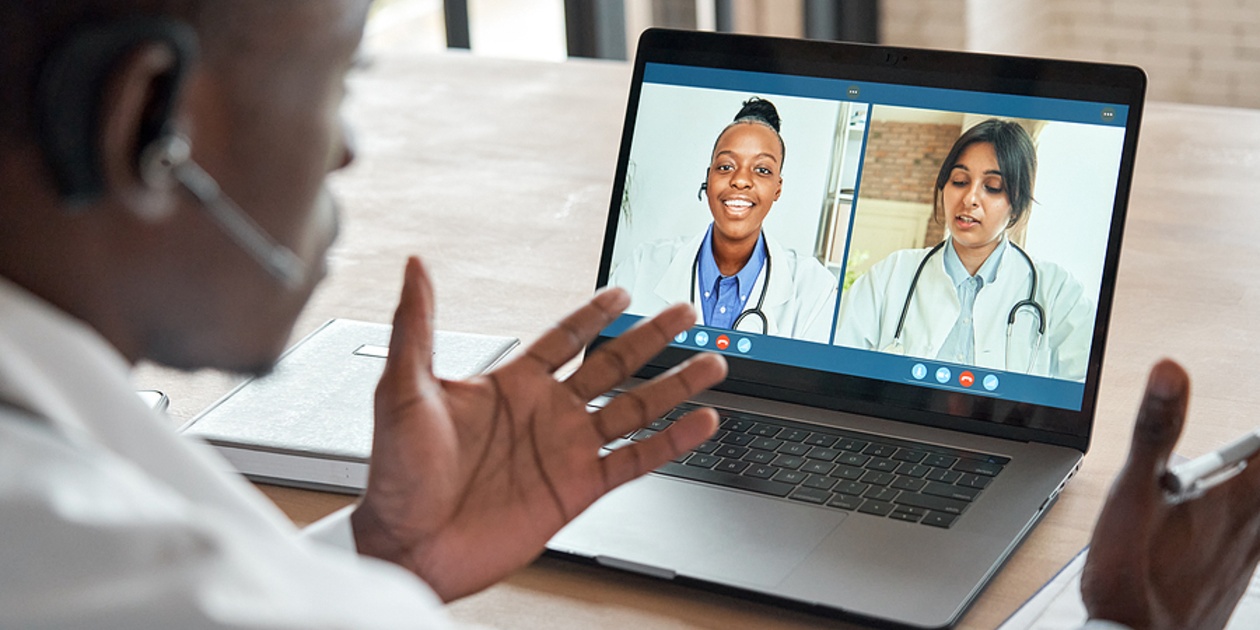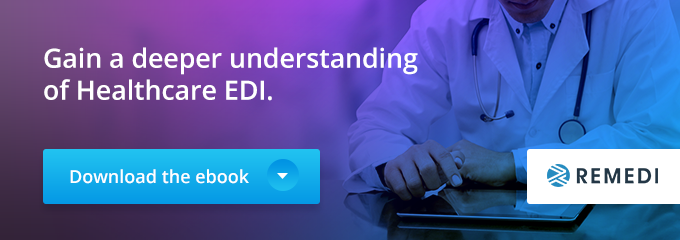
Take a moment to imagine this scenario: what if patients, clinicians, payers, researchers, and other stakeholders in the healthcare system were able to view comprehensive healthcare information? What if we pulled disparate healthcare information together in a single place, and what if that single-pane-of-glass view was simple to achieve?
That’s the goal of healthcare interoperability, and it’s moving from a goal to a reality. Read on to learn about the technologies that will enable healthcare interoperability, how they’ll affect payer/provider relationships, patient outcomes, and the healthcare industry as a whole. Gain a deeper understanding of Healthcare EDI. Download the ebook.
What Is Healthcare Interoperability, and Why Does It Matter?
“Healthcare interoperability” means that:
- Integration of internal data platforms, people, and processes so that decision-makers can act on data
- All information streams (such as a patient’s healthcare records, clinical data, and medical device information) appear in one place
- Information exchange takes place in a seamless and timely manner
- Healthcare stakeholders have streamlined access to information
- Healthcare stakeholders can easily gain insights from healthcare data
Why does it matter so much? For years, we've locked patient healthcare data in silos. That means that when patients and their healthcare providers need it most, it isn’t always available.
We’ll illustrate with two examples. In the first example, Jim and his wife Helen escape the winter in Michigan by traveling to Florida. Unfortunately, Jim gets into a car accident and breaks his arm. He’s taken to the hospital, where attending physicians have to rely on Jim’s memory of his health history as well as his awareness of allergies to any medication. It’s not an ideal situation, because if the staff had access to Jim’s health records, they could make better treatment choices.
“For years, patient healthcare data has been locked in silos”
The second example involves vaccinations for COVID-19. We’ll use Jim and Helen again to illustrate; the couple travels from Michigan to Florida and receives their first vaccine in a two-shot series. They each receive a little card saying they’ve received the first dose, but wouldn’t it be simpler as well as more efficient if we would digitize that information? Moreover, what if the clinic didn't store the batch that the couple received properly, and it’s not as effective?
Healthcare interoperability would ensure information about the vaccine batch (and the conditions of storage) is recorded. That data would help healthcare providers, and researchers understand the efficacy of the vaccines and spot any negative issues effecting them.
What Technologies Play a Role in Healthcare Interoperability?
In this article, we’ll talk about three categories of technologies that play a role in healthcare interoperability:
- APIs
- Healthcare EDI
- Healthcare integration that brings in other streams of information (such as medical device data)
APIs in Healthcare Interoperability
APIs stands for “application programming interfaces.” Think of APIs as electrical outlets: they allow you to consume a service (in this case, information from a database) when you connect a device (in this case, an application).
Within healthcare interoperability, APIs play an important role. They can call up information in response to queries. For example, a doctor examining a patient’s electronic healthcare record would use APIs to see if the patient has an allergy to penicillin before prescribing it.
“APIs allow applications to consumer information, which is crucial to healthcare interoperability”
To accelerate healthcare interoperability, the Office of the National Coordinator for Health IT has called upon the healthcare industry to adopt standardized APIs, specifically FHIR (which is short for “Fast Healthcare Interoperability Resources).
FHIR is a protocol that joins disparate systems to transmit information from one system to another. HL7 developed this draft standard.
“FHIR joins disparate systems to transmit information from one system to another”
Here’s how it works: each data element (known as a resource) has a tag. This tag acts as a URL – it doesn’t matter which operating system you’re using to access a website because a URL is always standard. The goal of FHIR is to standardize those resources, so it doesn’t matter which EHR you’re using to access them. Accessible, standard URLs allow several applications to access the information in an EHR.
The benefit of FHIR is that users don’t have to log into two separate systems to see the same information. Healthcare providers can see everything in the same place, which saves time, effort, and money.

Healthcare EDI and Healthcare Interoperability
Healthcare EDI is an electronic data interchange utilized in a healthcare setting. Through EDI, organizations in the healthcare industry can transmit data back and forth using standardized formats designed just for that industry. With healthcare EDI, manual data entry becomes a thing of the past (as do errors).
How does it work? EDI transmits messages in more than one way:
- Peer-to-peer messaging: partners exchange messages directly
- Value-added networks (VANs) serve as third-party routing services for messages; when the VAN receives the message, it looks at the delivery data and sends it to the recipient
- Mobile EDI
- Cloud EDI
Here’s what healthcare EDI looks like in action: software converts documents into a computer language, then assigns transaction codes to each document. Each transaction contains its own name, number, and usage information. Upon receipt, the recipient’s EDI software converts the information into documents once more, so they’re human-readable.
During the first Bush administration, concern rose for growing healthcare costs. In 1991, the Workgroup for Electronic Data Interchange was formed with the goal of significantly reducing inefficiencies in the American healthcare system.
“Healthcare EDI came about to address inefficiencies in the American healthcare system”
What’s healthcare EDI’s role in healthcare interoperability? Because healthcare EDI utilizes standard formats, it reduces the complexity created by multiple file formats. As a result, it’s faster and easier to obtain healthcare information.
Healthcare Integration for Other Information Streams
Today, there’s more information available to healthcare providers (and other healthcare industry stakeholders) about a patient. Medical devices transmit data, as do fitness trackers and other networked devices. This information is valuable and could help healthcare providers make better treatment decisions. Moreover, researchers could also make use of this data to gain a deeper understanding of health issues.
The question becomes, “How do you integrate these streams of information into one place?” That’s where healthcare integration comes in. A comprehensive healthcare integration suite brings together disparate information streams and consolidates them into a single version of the truth. Thanks to healthcare integration, healthcare providers have better access to healthcare information to make the right decisions.
The Impact of Healthcare Interoperability on the Healthcare System
Healthcare interoperability will have a positive impact on the healthcare system. We’ll look at three areas:
- Payer/provider relationships
- Patient outcomes
- The healthcare system overall
Payer/Provider Relationships
When we think of the payer/provider relationship in healthcare, what comes to mind is the word “adversarial.” Providers accuse payers of not approving life-saving procedures, while payers argue that providers could use more cost-effective procedures.
Healthcare interoperability could change that relationship by giving payers secure access to information. That makes it easier for them to collaborate and reduces the adversarial nature of their relationship.
Patient Outcomes
Healthcare interoperability will have a significant and positive impact on patient outcomes. It gives healthcare providers, and other stakeholders access to the latest patient information to make better decisions.
Let’s say that Dan is having chest pains. He has a fitness tracker that sends information to his EHR. Thanks to healthcare interoperability, doctors notice an irregular pattern in his heartbeat. They’re able to spot a serious problem before it gets worse.
“Healthcare interoperability will have a significant, positive impact on patient outcomes”
Through healthcare interoperability, providers have access to patient data in real-time, to avoid making deadly mistakes such as prescribing the wrong medication or missing out on crucial health data (such as that from medical devices or fitness trackers). Patients will have much better healthcare outcomes as a result.
The Healthcare System Overall
There are two major benefits healthcare interoperability has on the healthcare system as a whole
- It will be more efficient
- It will be more secure
Healthcare interoperability could save the US healthcare system over $30 billion per year. When healthcare organizations can easily share EHRs, everyone saves time and money by getting the right information to the right patient at the right time.
Moreover, healthcare interoperability boosts security in the healthcare system. It’s easy to add information to a patient’s EHR, so there are no more scraps of paper lying around with confidential information. An EHR also increases transparency – it shows you who entered information and when, and who accessed it. Because it’s easier to track user activity, it’s faster to pinpoint security problems before they become more serious.
“Healthcare interoperability enables the healthcare system as a whole to become more efficient and secure”
Healthcare interoperability is no longer a pipe dream – government regulations and advances in technology are making it a reality. Today’s healthcare organizations must embrace healthcare interoperability to stay relevant and competitive. Gain a deeper understanding of Healthcare EDI. Download the ebook.




